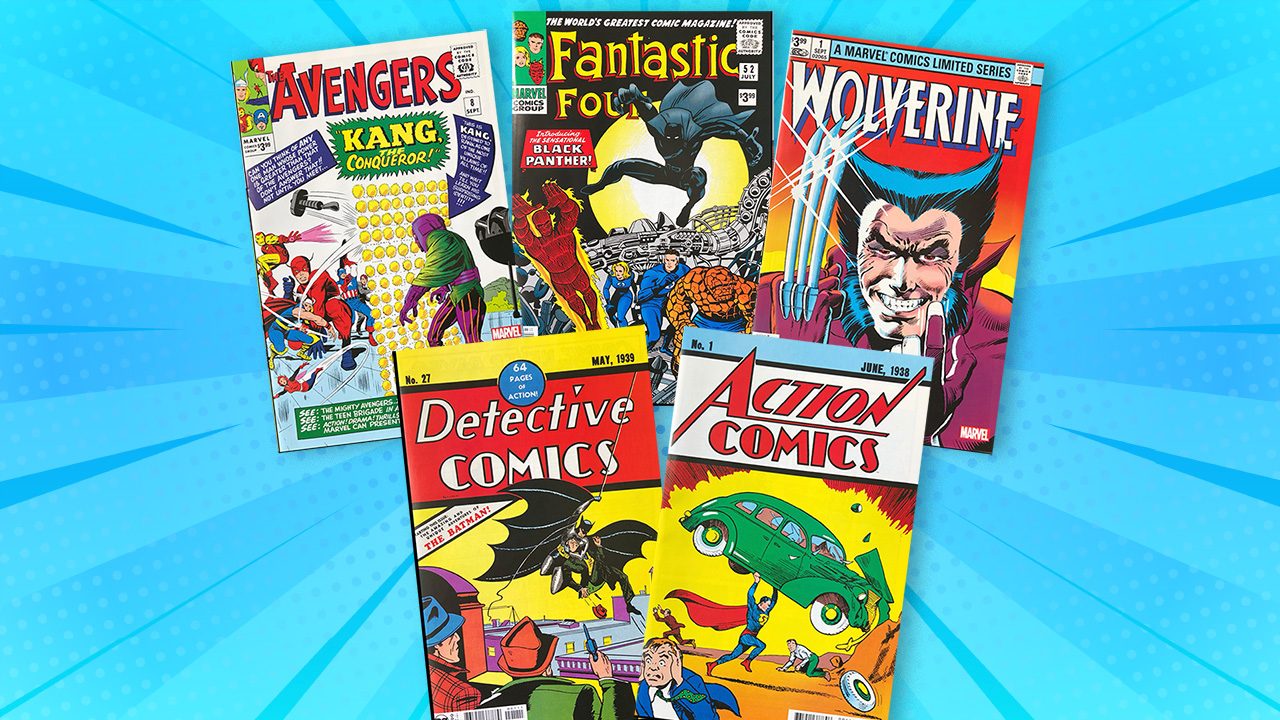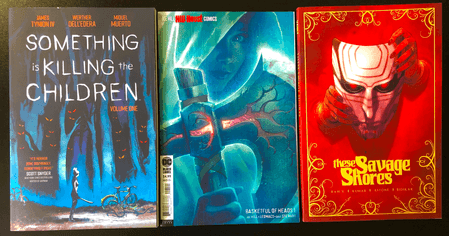SUMMARY
This is AI generated summarization, which may have errors. For context, always refer to the full article.

A vintage comic book can fetch a pretty penny depending on its physical condition and relative importance in comic book history.
Did an iconic character make a first appearance in the issue?
In September 2021, a graded copy of Amazing Fantasy number 15, published in 1962 and featuring the first appearance of Spider-Man, sold for a record $3.6 million at auction. That same year, a collector bought a copy of Action Comics issue number 1, which introduced Superman to the world in 1938, for $5.3 million.
The following year, in April 2022, a copy of Fantastic Four number 1, published in 1961, sold for $1.5 million. And a month later, a buyer shelled out $1.7 million for a copy of 1939’s Detective Comics number 27, which features the first appearance of Batman.
Did the story arc have a lasting impact on a larger narrative?
A graded copy of The Uncanny X-Men number 141, the first in the classic two-issue story arc Days of Future Past, sells for at least $100. Same with a copy of issue number 7 of DC’s 1985 massive cross-over event Crisis on Infinite Earths, where we saw the death of Supergirl. And while the prices for these books do not come close to those that iconic first appearances command, we would do well to remember that, when they were first published in the 1980s, they cost 50 cents and $1.25, respectively.
And while we can read these books online for a fraction of the cost, there is something to be said about owning a physical copy to add to our libraries. But the average reader does not have the wherewithal – or the willingness – to purchase copies of these seminal issues. The prices of even the raw, low-grade copies of these vintage books, especially those featuring first appearances of popular characters, can be substantial.
Enter facsimile editions.
For the last couple of years, Marvel, DC, and Image Comics have been publishing almost exact reprints of their classic comic book issues, including the often-funky advertisement pages and letters columns. But lest anyone is tempted to pass these off as their vintage predecessors, these facsimile editions are printed on glossy paper rather than the newsprint used for the original comic books. They also sport the new cover price, a barcode on the cover, and, for Marvel Comics at least, the new company logo.
With prices for raw copies usually ranging from the $4 to $8 range, these editions have made iconic comic books more accessible to both collectors and the public at large.
Here are the five facsimile editions we were excited to add to our library:
Detective Comics #27, DC Comics

Where better to introduce the Dark Knight, arguably the comic book world’s greatest detective, than in the pages of Detective Comics? In his first appearance, the Batman uses both brains and brawn to solve the mystery surrounding a string of murders of prominent industrialists.
The Batman, as originally conceived in this Golden Age-era comic book, seems to straddle the line between the campy Adam West version and the shadowy take of the Christopher Nolan trilogy. He cuts an imposing bat-shaped silhouette standing on a rooftop and with his cape billowing in the wind as he leaps through an open transom. But he drives a red sedan that looks like a 1936 Buick Roadmaster or a 1936 Oldsmobile rather than his iconic Batmobile and changes into his costume in his bedroom. And while this comic book did acknowledge that Bruce Wayne is the Batman’s secret identity, the story of how he became the Dark Knight is told six issues later, in Detective Comics #33.
The Caped Crusader’s six-page adventure is featured in issue #27 from May 1939, which also collects other serialized sleuthing stories, such as Speed Saunders Ace Detective, Buck Marshall Range Detective, The Crimson Avenger, as well as Spy and Slam Bradley by Superman creators Jerry Siegel and Joe Shuster.
Fantastic Four #52, Marvel Comics

Marvel’s First Family is set to debut in the MCU’s Phase Six in early 2025, giving us enough time to read up on the adventures of Reed and Sue Richards, Ben Grimm, and Johnny Storm. And while their origin story in Fantastic Four #1 would be the place to begin, Fantastic Four #52 gives us our first glimpse into the technologically superior African nation of Wakanda, as well as the first appearance of its iconic King T’Challa, the Black Panther.
Originally published in 1966, Fantastic Four #52 sees the Black Panther lure the famed super-hero team to his country as part of a ritual “hunt,” and uses his formidable hand-to-hand fighting skills and hi-tech weaponry to try to subdue the Four. The Black Panther we encounter in this issue is as strong, smart, and agile as his cinematic iteration. But he wears a cloth costume (with a short cape, mind you) rather than a body-fitting suit made of vibranium. In fact, T’challa’s vibranium suit makes its debut only three decades later, in the Marvel Knights-related Black Panther #1, published in 1998.
Action Comics #1, DC Comics

Faster than an express train. Able to raise tremendous weights, leap one-eighth of a mile, and hurdle a twenty-story building. If these phrases don’t ring a bell, try this: faster than a speeding bullet, more powerful than a locomotive, and able to leap tall buildings in a single bound!
When Superman debuted in Action Comics #1, published in June 1938, he could not yet fly but could leap over great distances. He was impervious to knives and bullets fired from pistols but was vulnerable when hit by a bursting shell. And while the comic book made clear that he is from another world, his Kryptonian legacy was not yet fully threshed-out and his origin story seemed to suggest he grew up in an orphanage rather than being brought up in the loving home of Jonathan and Martha Kent.
In many ways, Superman in 1938 was a world away from The Man of Steel we all know today. But the seeds of his greatness and his stature as one of the world’s most recognizable figures had been firmly planted.
Avengers #8, Marvel Comics

As the Marvel Cinematic Universe hurtles towards the colossal time-bending cross-over event that is Avengers: Kang Dynasty, it is high-time to read about Kang the Conqueror’s first appearance in the pages of Avengers #8, originally published in 1964.
A summons from the Pentagon brings the Avengers (by issue #8, the roster included Captain America, Iron Man, Thor, the Wasp, and Giant Man) to an emergency meeting to counter the threat posed by Kang, who introduces himself as a man from the future. He is haughty, megalomaniacal, and armed with superior advanced gear like the versions we’ve seen in Loki and Ant-Man and the Wasp: Quantumania.
Unlike his more contemporary cinematic iterations, however, the Kang in Avengers #8 is not yet the Master of Time he will become much later in the comic books. Other than having the ability to travel through time by means of futuristic technology, there is no indication here that he has the power to manipulate time. And aside from ret-conning Rama-Tut (who first appeared in 1963 in Fantastic Four #19) as the version of the character in Ancient Egypt, the appearance of multiple alternate versions of Kang is still some years away. The Council of Kangs, for instance, will first appear more than two decades later in 1986 in Avengers #267.
Wolverine #1, Marvel Comics

Marvel Studios’ announcement that Hugh Jackman is set to reprise his role as Wolverine in the upcoming Deadpool 3 movie sent social media buzzing. Arguably the most celebrated character in the X-Men franchise, Wolverine has been in the spotlight of many of the Merry Band of Mutants’ tales, such as the classic Days of Future Past, the second story arc of the wildly popular 1990s Jim Lee reboot (issue number 1 of this run remains the best-selling single-issue comic book in history, selling more than 8 million copies), the massive cross-over event House of M, and the critically acclaimed Uncanny X-Force and the House of X/Powers of X maxi-series from 2019.
Though the first entry in this four-issue 1982 mini-series is not Logan’s first appearance (that would be in 1974’s Incredible Hulk #180 and #181), Wolverine #1 threshes out important aspects of his backstory, including his Canadian heritage and deep connections with Japan. In this comic book, Wolverine is more introspective and restrained, as opposed to the brash, no-holds-barred fighting machine we usually associate with the name.
In the coming months, new facsimile editions will hit the stands. These include seminal issues, such as Avengers #1 (1963, the first time Iron Man, Thor, the Hulk, the Wasp, and Giant Man form the super-team), X-Men #1 (1963, our first encounter with the original X-Men team of Cyclops, Marvel Girl, Iceman, Beast, and Angel, as well as Professor X and Magneto), Amazing Spider-Man #121 (1973, which tells the story of the tragic death of Gwen Stacy), and the all-time best-selling comic book, X-Men #1 (1991, featuring the superb team-up of writer Chris Claremont and artist Jim Lee, the first appearance of the X-Men’s Blue and Gold Teams and their now-classic uniforms).
Now, iconic comic book issues which have erstwhile been out of reach of the average collector have been made more readily available. With the amazing stories featured in present-day comic books combined with easier access to seminal works from as far back as the Golden Age courtesy of these facsimile editions, it is truly a great time to read comic books! – Rappler.com
Rory J. Bolivar is a registered microbiologist and educator.
Robespierre L. Bolivar is the recipient of the Gawad Mabini, one of the highest Presidential honors bestowed upon Filipino diplomats.
Follow them on Facebook @robroryreads and visit their website. Their new book, ‘Thoughts From Our Couch,’ a collection of their essays on life, books, movies, and popular culture, is now available on Amazon.com worldwide.
Add a comment
How does this make you feel?

There are no comments yet. Add your comment to start the conversation.